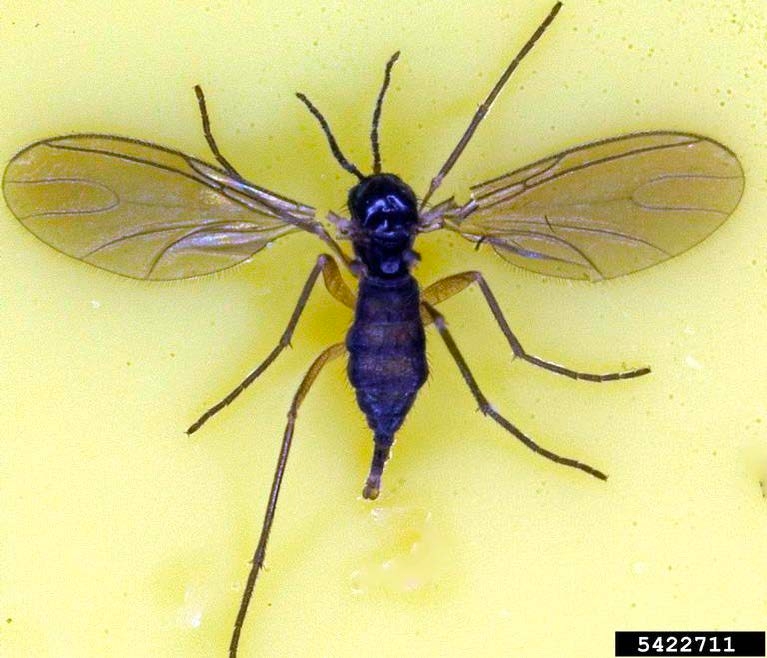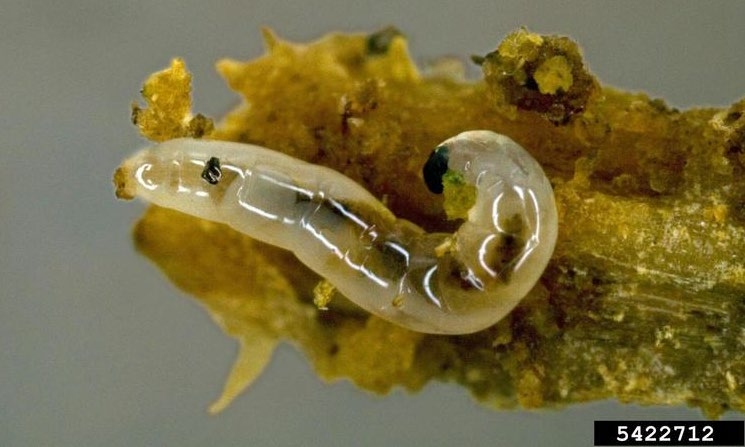Fungus Gnats
ID
3104-1579 (ENTO-442NP)
Identification
Fungus gnats (Diptera: Sciaridae) are pests of greenhouses, nurseries, and indoor plantscapes, as well as being common household pests. The adults are slender, delicate, mosquito-like gnats with grayish to black bodies. They have long legs and measure about 0.12 inch (about 3 mm) long (Fig. 1). The wings are transparent but often with smoky-gray shading. Adults are weak fliers.

The larvae are slender, pale, worm-like maggots with a dark head capsule. The digestive tract can often be seen through the thin integument. They measure up to 13 mm (0.5 inch) long.
Host Plants
Larvae feed on highly organic soils and can damage the roots of bedding plants, African violets, carnations, poinsettias, and foliage plants. Overwatering and excessively wet soil or container media promote fungal growth and root rot in potted or container plants, which support fungal gnat larval populations.

Description of Damage
Fungus gnat larvae typically feed on decaying organic material, including unhealthy plant roots, but sometimes they also feed on healthy root systems. Heavy populations of fungal gnat larvae may cause yellowing and dropping of leaves and leading to stunted plant growth. Young plants without strong root systems are more susceptible to damage.
Adult fungus gnats do not bite, but their presence can be a nuisance indoors.
Life History
Fungus gnats have a complete life cycle consisting of the egg, larval, pupal, and adult stages.
Adult females lay eggs in moist decaying organic matter. Fungus gnat larvae live and pupate in this material within 13 mm (0.5 inch) of the soil surface. These conditions are abundant outside in the fall season and nearly year-round in potted plants grown indoors or in greenhouses. Warmer temperatures decrease developmental time, allowing for multiple generations to quickly build up in greenhouse or indoor settings.
Chemical Control
In severe infestations, consider using a soil drench of an insecticide labeled for use on houseplants or greenhouses. Follow the insecticide recommendations in the current Virginia Pest Management Guide for Home Grounds and Animals (PMG 456-018) for home owners, or in the Horticultural and Forest Crops (PMG 456-017) for commercial growers. Chemical control needs to be combined with proper moisture management that addresses overwatering to successfully obtain control.
Cultural Control
Cultural control of fungus gnats in the house is relatively simple. Adult fungus gnats are attracted to moist soil containing wet decaying organic matter. Examine all houseplants for signs of over watering and allow the soil to dry out until the top 13 mm (0.5 inch) of soil is dry. This is probably the best and easiest control for these pests. Any larvae present in the top layer of soil will die without excess moisture, and adult female fungus gnats will not have an attractive place to lay their eggs.
Yellow sticky cards can be used to trap and monitor adult fungus gnats in houses or greenhouses, but addressing the excess water in the soil is key to controlling these pests.
Revised
Theresa A. Dellinger, January 20, 2021.
Virginia Cooperative Extension materials are available for public use, reprint, or citation without further permission, provided the use includes credit to the author and to Virginia Cooperative Extension, Virginia Tech, and Virginia State University.
Virginia Cooperative Extension is a partnership of Virginia Tech, Virginia State University, the U.S. Department of Agriculture (USDA), and local governments, and is an equal opportunity employer. For the full non-discrimination statement, please visit ext.vt.edu/accessibility.
Publication Date
March 4, 2021



